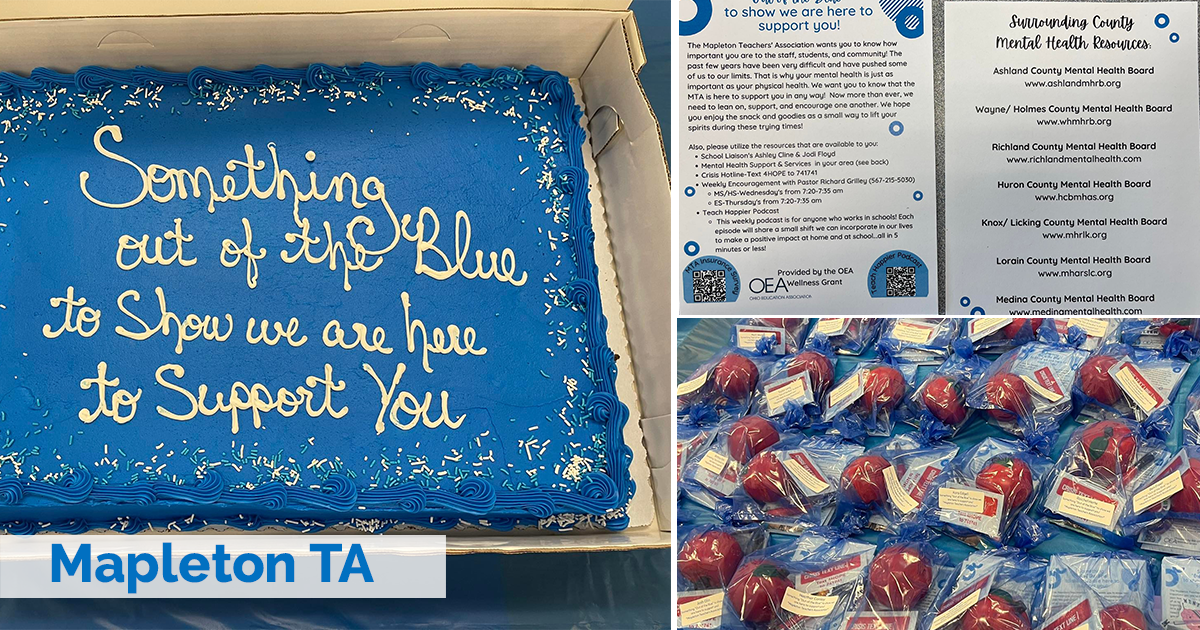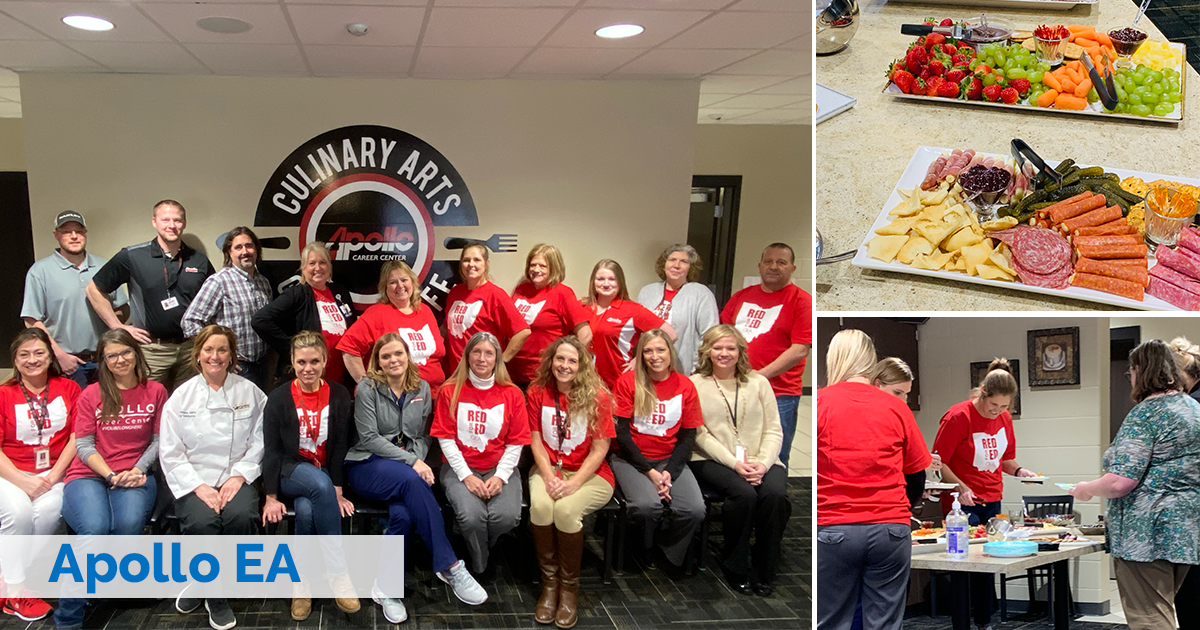Let’s get the facts straight on public school funding
By Scott DiMauro, Ohio Education Association President
As a high school social studies teacher, I was always struck by what the then-future US President John Adams said during the criminal trial following the Boston Massacre: “Facts are stubborn things; and whatever may be our wishes, our inclinations, or the dictates of our passion, they cannot alter the state of facts and evidence.”
The fact is that Ohio’s public schools serve nearly 90 percent of students in our state. And, despite recent claims that attempt to twist the truth around public school funding in Ohio, the evidence is clear: More work must be done to finally fully and fairly fund our public schools, so that every child – regardless of where they live, what they look like, or how much money their parents make – can receive the excellent education they deserve.
The fact is that Ohio’s public schools are funded from the same line item in the state budget as private school vouchers. The last state budget did provide “record funding” for that line item, as indeed, anytime there’s an increase, that would set a new record. As noted in recent news coverage, the Ohio Department of Education and Workforce doesn’t yet know how much the state’s new universal voucher program will cost this year. But, with the explosion in the number of wealthier families taking public taxpayer dollars to pay for private school tuition for students who were already attending private schools in the first place, it is clear the state’s spending on the universal voucher program will far exceed the original budget estimates.
So, the fact is, when it comes time to pass the next state budget in 2025, that leaves less money in that line item for Ohio’s public schools. Exactly how much less and how will that impact public schools? It’s unclear. But, the uncertainty around those questions is causing school districts across the state to hold onto larger reserves to weather future state funding shortfalls, and in some cases, has prevented districts from feeling comfortable spending down the soon-to-expire federal pandemic-relief money that is currently inflating some of the figures. In the end, that uncertainty is hurting our students, as money that should be used to recruit and retain public school educators, address students’ mental health needs, and make up for lost ground remains unspent.
The Fair School Funding Plan, when fully implemented with updated formula components, should remove that uncertainty. Based on years of work and input from stakeholders across the board, the Fair School Funding Plan, which the state began phasing in in the FY 2022-23 budget, is meant to accurately account for how much it costs to educate a child and how much a local community can actually afford to pay toward that. And, it provides a predictable funding model, so school districts can accurately plan ahead. If the Fair School Funding Plan is fully phased in in the next state budget, as it was always intended to be, Ohio would finally have a constitutional school funding formula for the first time since the state supreme court started telling the legislature to stop chronically underfunding our public schools and truly fix the problems back in 1997.
Our lawmakers need to fulfill Ohio’s promise to our kids and commit to fully adopting the Fair School Funding Plan. They need to ensure that public tax dollars spent on private school vouchers come with the same academic and financial accountability as the dollars we spend on our public schools. They need to focus on providing the supports and resources our students need to succeed in a 21st century economy, because in Ohio, public education matters.
Student Loan Forgiveness
If you are looking for information on eligibility for debt forgiveness, we recommend you visit : Student Debt Cancellation, PSLF & More: What Educators Need to Know | NEA. Also visit the NEA Student Debt Navigator, a powerful toll that can help manage student loan debt, find forgiveness options and the lowest payment options at no cost! To be best prepared, be sure you have created an account at NEA Member Benefits. Start here: www.neamb.com/start
 Need help understanding what’s going on with student loans and loan forgiveness?
Need help understanding what’s going on with student loans and loan forgiveness?
NEA Member Benefits will share the latest about student loans and loan forgiveness as we enter a time of great uncertainty.
No pre-registration is required. Simply join the session(s) most convenient for you:
- December 16 at 4:00 p.m. ET
- December 17 at at 6:00 p.m. ET
- December 18 at 7:00 pm ET
If prompted: MEETING ID is 823 2915 5910 and the PASSCODE is 815183
NEA Member Benefits will help make sense of loan repayment & forgiveness, the current administrative forbearance and options borrowers have, rule changes, what the future of loan forgiveness looks like under a new administration and learn about the NEA Student Debt Navigator and how it can help NEA members manage their student loans and forgiveness options at no cost.
Celebrate Educators with the Columbus Blue Jackets!
Join the Columbus Blue Jackets for CBJ Educator Spring Ticket Offers!
Every season, the CBJ wants to take a moment to re-thank our Educators & school staff for all their support in the community by providing another exclusive ticket promotion. | #ThankATeacher
- March 15 – CBJ vs NY Rangers | 7 PM
- March 17 – CBJ vs NJ Devils | 7 PM
- March 28 – CBJ vs Vancouver Canucks | 7 PM
- April 17 – CBJ vs New York Islanders | 7 PM
This season, with this CBJ Educator Spring Offer, Educators & school staff members can get discount tickets to a few select upcoming games that also come with our Value Meal Voucher to include Food & Beverage with every ticket!
If you have more than one educator in your group, or any additional questions, please call Alec Rivers at (614) 246-3852 or email arivers@bluejackets.com.
Groups of 10 or more will also qualify for even more savings on tickets!
Fear and Power: What Really Drives Issue 1
By Julie Holderbaum, Minerva EA/OEA
A teacher tells his students that phones are not allowed in class. One day, a student points out that the teacher is often on his phone. The teacher replies that the rule doesn’t apply to him, only to them.
A student turns in a research paper a day after it is due. The student knows that 10% will be deducted from the final score, which is the teacher’s late work policy established at the beginning of the year. However, the paper is returned with 50% deducted from the grade. When the student questions the teacher, the teacher simply says that she changed the rules.
A teacher decides to allow students to vote on whether to have homework assignments during the school year and 59% of the students vote not to have homework. When the teacher shares the results, a majority of the students rejoice! But then the teacher announces that since the NO votes didn’t reach 60%, homework is going to stay.
Any credibility these teachers had would be damaged at best and quite possibly destroyed by these actions. Not following their own rules? Changing the established, fair policies to much harsher ones? Eliminating majority rule? These teachers would be viewed by their students as hypocritical, manipulative, and untrustworthy…which is exactly how we should view the Ohio legislators who support Issue 1.
Ohio Legislators are failing to follow their own rules
In December 2022, the Ohio General Assembly voted to eliminate August elections in most cases. But now those same lawmakers argue that the rule they enacted doesn’t apply to them; it only applies to small, local elections.
Why the change of heart? Because a grassroots group of Ohio citizens has submitted petitions to get an amendment on the November ballot that would protect reproductive rights in Ohio.1
Many Republicans, who hold a supermajority in Ohio, do not want to see the citizen-based reproductive rights amendment pass in Ohio. Look, reasonable people can have reasonable disagreements on reproductive rights. But changing the rules to rig the democratic process is not what Ohioans want, and that is exactly what corrupt politicians did when, in spite of banning special elections in August less than a year ago, they put Issue 1 on the August Special Election in an effort to preempt the November election and make it more difficult for a citizen-based amendment to pass.
Ohio Legislators are changing well-established, fair policies.
Proponents of Issue 1 say its purpose is to defend the Ohio Constitution against frequent attacks of special interest groups. What legislators are really trying to protect is their own power and take freedoms and rights away from the citizens of our state. When Ohioans made it clear that we are willing to exercise our rights to try to amend the Constitution when legislators fail to represent our values, the legislature put an issue on the ballot that would make it difficult for citizens to ever again affect a change in the Constitution.
It is already extremely difficult for a citizen-led group to get an amendment to the Constitution on the ballot. There are multiple steps that require signature gatherers to obtain certification from the Ohio Attorney General, the Ohio Ballot Board and meet signature thresholds both at the statewide level and in 44 of Ohio’s 88 counties. Since 1913, only 71 citizen-based amendments have made it to the ballot, and of those, only 19 were approved by the voters. This is most certainly not an overused tactic to change the Ohio Constitution.
If Issue 1 passes, instead of meeting the signature requirement in 44 of Ohio’s 88 counties to move a proposal to the ballot, the threshold would need to be met in all of Ohio’s 88 counties, giving a single county the ability to thwart the will of the remaining 87. Issue 1 also eliminates the 10-day period petitioners have to gather more signatures if not enough of the original signatures meet the requirements. These harsher demands make getting a citizen-led proposed amendment to the Constitution extraordinarily unlikely and cede all ability to amend the Constitution to deep pocketed special interest groups (some of whom may not even be in Ohio) and the Ohio General Assembly.
Ohio Legislators are ending majority rule.
In the unlikely event that an amendment makes it to the ballot, Issue 1 would require that 60% of Ohioans must approve an amendment in order for it to pass, as opposed to the current standard of a simple majority, 50% + 1. (Ironically, Issue 1 only needs a simple majority to pass). Majority rule has been the default threshold for victory in Ohio elections for more than 100 years, but fearful of losing their power to ordinary (and organized) citizens, the legislature decided to change what determines a winner mid-game, handing the ability to veto the will of the majority of voters to a minority of the vote. Issue 1 is an attack on our voting rights, plain and simple.
It’s crucial to remember, however, that Issue 1 is not about abortion.
Issue 1 is about all citizen-proposed amendments to the constitution, not just one, as Secretary of State Frank LaRose says. He stated (rather disrespectfully, I would argue): “(Issue 1 is) 100% about keeping a radical pro-abortion amendment out of our constitution. The left wants to jam it in there this coming November.”2 Jam it through? Is that how he views Ohio citizens who exercise their democratic rights by following the legal (and lengthy) process to make changes to the state constitution?
Let’s be real. The move to protect reproductive rights is simply the catalyst causing our legislators to fear losing their unilateral power.
They’ve managed to largely protect their own power by gerrymandering the state, but citizen-based amendments to the constitution represent a threat that there is no easy way to quell, short of changing both the rules that have been well- established for years, and the rules they set themselves less than a year ago.
Regardless of the outcome of Issue 1 in August, the reproductive rights amendment is heading for the November ballot. I urge you to base your vote in November on your feelings about abortion and reproductive rights.
But I beg you, don’t base your vote in August on your feelings about abortion and reproductive rights. Issue 1 has nothing to do with that. Issue 1 has everything to do with an already powerful legislature trying to further silence their constituents. Their gerrymandered supermajority affords them the ability to pass a myriad of laws with impunity, but that’s not enough for them. They want to take away one of the only guardrails we have left as citizens to determine the future of our state when one party gains a trifecta of dominance in our state government and stops listening to the desires of we, the people of Ohio.
It’s worth noting that the egregious consequences of passing Issue 1 would impact BOTH parties.
Republicans and Democrats alike have the same rights to get a proposed constitutional amendment on future ballots, about any number of issues. Issue 1 makes this more difficult, regardless of the political leanings of the citizens who begin the process.
I wonder if the legislators who support Issue 1 are more afraid of losing power or of the Ohioans who refuse to remain silent and allow the legislature to set the course for our state without our input?
As educators, we must be vigilant in using our voices to advocate for change when laws are manipulated to reflect personal agendas instead of the will of the people. With the recent expansion of universal vouchers, the state will spend billions of dollars, with little oversight, funding private and charter school tuition and homeschooling for families, regardless of how wealthy those families might be. Furthermore, the legislature has stripped power from the elected State School Board and given much of the decision-making authority in education- related issues to an appointed partisan official.
With legislators making moves like this, we can ill afford to lose any of the tools we have as citizens to make changes that better reflect the interests of Ohio’s educators, students, and families.
Ohio legislators who support Issue 1 might well be motivated by a fear of losing power. But there is great power in losing the fear of standing up to those who ignore our interests.
Fear, I predict, will fail. Because just like the teachers in the scenarios above would quickly lose credibility, our legislators are playing games that will cost them the trust of Ohioans.
Join me in voting NO on Issue 1 this August and send the message to politicians and their special interest backers that we, the people of Ohio, will fight for our freedom and right to determine the future of our state.
1 The full text of the proposed amendment can be found here: https://www.ohioattorneygeneral.gov/getattachment/cf27c10f-b153-4731-ae9e-e3555a326ed9/The-Right-to-Reproductive-Freedom-with-Protections-for-Health-and-Safety.aspx
2 https://signalcleveland.org/everything-you-need-to-know-about-the-august-vote-on-issue-1/
A Teacher’s Brain Following Yet Another School Shooting…and Yet Another Misguided Response by Legislators
By Julie Holderbaum, Minerva EA/OEA
Another school shooting? 19 students killed? And two teachers?
He bought the AR-15s legally, just days after his 18th birthday? And bought another weapon just a few days after buying the first, with a high-magazine clip? Doesn’t anyone besides me see that there should be a red flag in some system somewhere that signals local police to check this person out?
Would it have made a difference in this case? Maybe not…but we will never know, will we?
Is this for real? Is a local group really raffling off an assault rifle as a fundraiser for a youth program? Are they really asking kids to sell tickets for an assault weapon when kids were just slaughtered with the same type of gun, to the point of needing a DNA sample to be identified? I’m not sure if there is ever a right time for that sort of fundraiser, but less than a month after Uvalde?
And now the legislature passed what? A bill to LOWER the number of required training hours to 24 for teachers to carry a weapon in school? Didn’t my daughter need 50 hours of behind-the-wheel training just to get a driver’s license? Why would a teacher, who is not in the field of law enforcement, need so few hours of training to carry a gun in a school?
How would that even work? Would it be a hand gun? Locked and loaded in a drawer somewhere? Is a handgun going to be any deterrent to a person carrying an assault rifle? Would I have time to get to it if I needed it? And how would I know I needed it? A loud noise in the hall? Would I get my gun and peek my head out to see if action is needed? Would eight other teacher heads be peeking out in my hallway, guns drawn?
If nothing was wrong and we grabbed our weapons in error, would the students in our classes be traumatized by seeing their teachers with loaded guns?
Or has this lockdown-drill-school-shooting cycle become so normalized to them that they wouldn’t even be phased at seeing the same people who teach them their ABCs or pre-calc wielding a dangerous weapon? And if so, what does that mean for the future of our country?
And what if the threat wasn’t in the hallway, but in my classroom? One of my students? Even if I could get to my gun, would I have the ability to shoot one of MY kids? Knowing he suffers from depression and can’t use our school resource mental health counselor because of insurance issues? Knowing his past experience with abuse? Knowing that he has not felt seen or heard or loved at home in years?
Could I shoot that kid?
And if I did use my gun, even if I saved lives, could I live with myself? What would the repercussions of pulling that trigger have for my own mental health? Would I ever be able to look at my students the same way again? Would they ever be able to see me in the same way again?
What if I hesitated? What if more were hurt because I struggled to pull the trigger? How could I ever teach again? How could anyone trust me again? How many lawsuits would I face because I didn’t act fast enough?
If trained law enforcement officers hesitated to enter Robb Elementary School in Uvalde, what makes anyone think teachers would be comfortable entering a spray of gunfire and endangering themselves? Especially with only 24 hours of training?
 On the other hand, how many lawsuits would there be if I leapt into action, misread a situation, and shot an innocent person?
On the other hand, how many lawsuits would there be if I leapt into action, misread a situation, and shot an innocent person?
If we were required to actually carry our guns with us at all times, could I ever concentrate enough to teach effectively? How can I teach my students that words can change the world, that literature can move souls, that the power of a well-turned phrase can penetrate the hardest of hearts… while carrying a gun?
How’s that for a mixed message? Words have power, but guns are faster? Is that what we want to teach?
Beyond sending mixed messages, could I ever teach without constantly worrying about my weapon? About who is looking at it oddly today, about turning my back on anyone, about helping one student at her desk while my gun is about 2 feet away from the hands of the student in the desk next to hers? Would I have to keep one hand on my weapon at all times? As a TEACHER?
Surely I wouldn’t be required to carry a gun, though, right? I already check my classroom door multiple times a day to be sure it’s still locked; I already weigh the options of teaching with my door shut and locked for safety from shooters to teaching with it open to allow for more airflow and safety from COVID; I already jump at every odd sound or unannounced lockdown; how much worse would it be if I knew multiple people in our building were carrying guns?
This legislation won’t just affect the mental health of our students, will it?
I’m so tired of hearing that “the only thing that stops a bad guy with a gun is a good guy with a gun”; if that’s true, why were weapons not allowed at the recent NRA convention in Texas? How could a room full of good guys with guns be a threat? Shouldn’t that be the safest place in the world? Why aren’t more responsible gun owners fighting for universal background checks, for a raise to the age limit to buy certain guns, for red flag laws, for a required waiting period before possessing a gun after purchase?
With so many Americans in favor of at least some reform to gun laws, are legislators who refuse to advocate for safer gun laws just afraid of losing their jobs? Afraid that without the money of the NRA and other pro-gun lobbyists they won’t be able to fund a successful campaign? That they would lose their power, their position, their ability to provide for their families? But don’t those same legislators force educators to live with those fears every day, knowing that if we teach about racism or other sensitive topics in the wrong way, we could lose our jobs thanks to their laws?
If they think we can’t be trusted to discuss elements of America’s troubled past or the current events of the day in a responsible manner, why would they deem us responsible enough to carry a gun in school?
When will our politicians put people over power? When will they set aside pride to work with the other side? When will the safety of our communities take precedence over an election?
If the politicians currently in office aren’t willing to make changes, is the blood of the victims of the next shooting on their hands….or on ours?
If this isn’t the time to persist in our efforts to persuade responsible gun owners to join the cause, when is?
If this isn’t the time to promise our children that we will do more than pause to remember the victims and pray that this never happens again, when is?
If this isn’t the time to preserve the sanctity of our classrooms as places of learning, belonging, and growing, when is?
If this isn’t the time to pursue real action by promoting politicians who run on a platform of actual changes to the law, when is?
If this isn’t the time to protest, when is? Aren’t the protest signs true? “The power of the people is greater than the people in power?”
Isn’t the truest form of political protest voting out those who have made empty promises but not practical efforts at positive change?
How many days until November?
OEA condemns latest version of House Bill 327
[February 16, 2022] The Ohio Education Association (OEA) stands with the majority of Ohioans who believe all children deserve the opportunity to receive an honest and reflective education that empowers them to become critical thinkers and strong future leaders.
OEA is appalled by the continuing efforts of certain politicians to force through House Bill 327, which would force educators to whitewash our history and distract from the real issues facing Ohio’s schools. OEA calls on the Ohio House of Representatives to end consideration of the bill.
The revisions included in substitute HB 327, as introduced Wednesday, do nothing to address the irreparable harm this legislation would cause to Ohio’s students. And it actually makes the potential dangers to educators and administrators more confusing. The current version replaces the bill’s original and undefinable “divisive concepts” language with vague references to the 1964 Civil Rights Act, apparently requiring Ohio educators to become constitutional law experts in order to understand what the bill’s sponsors don’t want them teaching.
“Make no mistake, this latest version of HB 327 is just another exercise in smoke and mirrors by some state leaders to deflect their constitutional responsibility to fully fund all of Ohio’s public schools and provide Ohio’s children with the resources they need to succeed,” OEA President Scott DiMauro said. “The lawmakers behind this horrendous bill can dress it up anyway they want as they continue to do the bidding of a national network of extremists who are looking to control the political narrative at any cost. But this new version is just as outrageous and inexcusable as the prior version. And in some ways, it’s worse.”
OEA will continue to stand up for honesty in education and against government censorship in the classroom. Ohioans must come together and call on their elected leaders to do better for Ohio’s students.
“Educators and parents know children must have the opportunity to reckon with the mistakes of our past in order to create a better future for all of us,” DiMauro said. “Instead of anti-freedom state censorship laws, let’s work on pro-student policies like fair funding and better access to learning opportunities for all students.”
Backpack Bill would come at enormous cost
“Ohio lawmakers have a constitutional responsibility to fund Ohio’s public schools and ensure a high-quality education for all of Ohio’s kids. HB 290 would force local communities to rely even more heavily on local property taxes to fund schools for the 90 percent of Ohio children who attend public schools. There’s evidence under our current voucher system that public schools out-perform the private schools,” OEA President Scott DiMauro said, citing a Cincinnati Enquirer investigation that found nearly 90% of all voucher students do worse on state tests than students in traditional public schools in the same zip codes.
“Dumping precious resources into a universal voucher system that provides zero auditing requirements for the private schools that would rake in the taxpayers’ cash is just wrong,” DiMauro added. “This is especially true now, when Ohio finally has a public school funding system worth investing in after the adoption of the Fair School Funding Plan in the last state budget. Our lawmakers must hold up their end of the deal to fully fund that system before going off on yet another ideological misadventure with our hard-earned tax dollars. Taxpayers don’t need another ECOT-level disaster and scandal.”
Disturbingly, even with these vouchers, most families still couldn’t afford tuition at the private schools in their communities, and this exponential expansion of a vouchers system in the state would only further contribute to racial segregation in our schools. In Ohio, only about 50% of the subsidies currently being taken are being taken by non-white parents, even though the communities where about 95% of the vouchers come from are nearly 70% non-white. Only 37% of students in Lima City Schools are white, yet Temple Christian School gets $242,000 in taxpayer tuition subsidies and took 100% white students. Likewise, Lima Central Catholic takes more than 70% white students, St. Gerard and St. Charles take about 80% white students. Simply put, these private schools do not reflect the racial makeup of the communities that are forced to pay their bills.
“Ohio taxpayers can’t afford to shell out more money for voucher programs that weaken the public schools that serve the vast majority of Ohio’s kids,” DiMauro said. “We’ve been down this road before and we know it is a dead end in Ohio’s budget. When only 74% of students were eligible for government subsidized private school tuition in 2017’s SB 85, the non-partisan Ohio Legislative Service Commission estimated the cost as high as $1.2 billion. And that was with lower subsidy amounts. This bill will cost (conservatively) two or even three times that amount. Asking Ohioans to pay for that at the expense of their neighborhood public schools is irresponsible and wrong.”
OEA applauds court decision striking down gerrymandered maps
“The Ohio Education Association (OEA) applauds the wisdom of the Ohio Supreme Court in striking down the gerrymandered maps that would have denied Ohioans a real voice in the Statehouse. This is a huge victory for Ohio voters and for Ohio schools, which are greatly impacted by the decisions of the state’s elected lawmakers.
OEA looks forward to seeing newly drawn, fair maps that will reflect the will of the two-thirds of Ohio voters who demanded an end to Ohio’s broken mapmaking process. Ohio voters deserve to choose their politicians, not the other way around. Today’s Ohio Supreme Court decision represents a major step toward making that a reality.”
The Benefits of Shopping with NEA Member Benefits

HOLIDAY SHOPPING USING NEA MEMBER BENEFITS
NEA Members can really make their membership pay this holiday season using their NEA Member Benefits! Want to learn how? Join us through ZOOM on any of the dates and times below using the same zoom link for any and all. Give us 30 minutes and we just might change the way you shop now and after the holidays. No pre-registration is required.
December 6 starting at 4:30 P.M. Eastern and REPEATED again at 5:05 and 5:40
December 8 starting at 7:30 A.M. Eastern and REPEATED again at 7:35 and 8:10
December 9 starting at 6:00 P.M. Eastern
These events have ended.
Wellness Grant
OEA’s Wellness Grants Help Locals Support Member Well-Being
- Up to $5/per Active Member
- Submission and Approval of Application Required
- Activity Must be completed between September 3, 2024 – May 31, 2025
- Receipts must be submitted for Reimbursement by June 15, 2025
- Share photos with LRC to post on the OEA Wellness Website
- Contact LRC for Application
- Share your events on social media using #OEAWellnessGrant, #OEAWG, and #OEAWellness
- Click here to download a Wellness Grant application
- Wellness Grants Funds cannot be used for the following: T-shirts, Gift Cards/Gift Certificates, Cash Gifts to Members, or Lottery Tickets
WELLNESS GRANT ACTIVITIES
- Laughter As The Best Medicine – Set a movie event for members. A comedy or light-hearted movie is suggested. Provide members with movie “snacks” as they share an opportunity to laugh alongside fellow members.
- Social Time Members Uplifting Members – Organize an event – perhaps a happy hour or coffee chat – where members can relax and spend time together in a social setting.
- Pop-up Café – Set up a pop-up café that offers members snacks and positive messages. The café could be as simple as a table staffed by other members or a coffee/tea bar.
- Drop-in Spa – Create a drop-in spa for members in buildings. Members can sign up for time to experience a relaxing environment with a massage chair, healthy snacks, and beverages.
- Wellness Passport/Self-Care BINGO – Provide members with a Wellness Passport with pages to be stamped for each self-care activity they do on their own. Create a BINGO card with self-help activities for members to complete. The activities for the passport or BINGO card could include such things as: exercise classes, virtual challenges, book clubs, and meditation. Award members with a gift with a completed passport or completed BINGO card.
- Special Delivery! – Create a monthly drawing for all members. Winners will receive a special delivery of flowers, cookies, candy, self-care bags, or books, and a positive message from their local.
- Lunch and Learn – Invite members to an hourlong lunch and training focused on a wellness activity or skill such as meditation or an art/craft. The lunch hour could include a speaker on a topic related to self-care. Ask members to complete a self-care survey during the lunch and learn.
- Keep Active and Be Healthy Challenges
• Walk/Step Challenge – Provide each member who signs up for the challenge with a promotional Local water bottle, notebook, pen, and information on the health benefits of walking. Create a members-only Facebook or Instagram page for the challenge. Ask participating members to set a personal goal for the 30-day challenge, keep track for 30 days, and post/share positive thoughts via social media.*
• Sleep Challenge – Provide each member who signs up for the challenge with a sleep mask, earplugs, herbal tea, notebook, and information on the health benefits of sleep. Create a members-only Facebook or Instagram page for the challenge. Ask participating members to set a personal goal for the 30-day challenge, keep track for 30 days, and post/share positive thoughts via social media.*
*Members who complete the 30-day challenge receive a certificate and gift - Local’s CHOICE! – Develop a Wellness Themed Activity of your own!
“I got great feedback from some staff that said they appreciated the nice surprise on a cold Monday morning – a goodie bag with items with a note attached explaining how each item can be applied to their own personal wellness”
A sample of locals who have received a Wellness Grant










